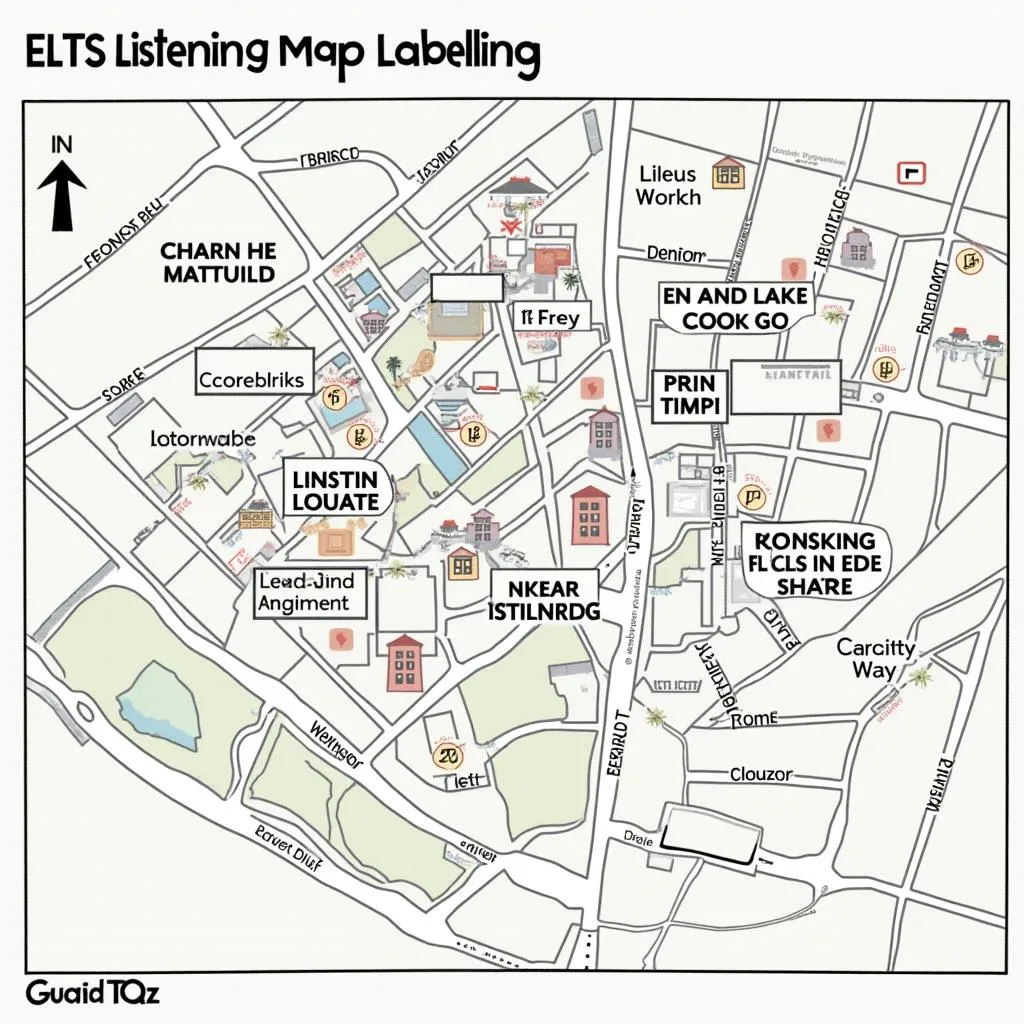Understanding Map Labelling in IELTS Listening
Map labelling is a common task in the IELTS Listening test, requiring candidates to accurately identify and label specific locations or features on a map. This task assesses your ability to comprehend spoken descriptions and follow directions, skills that are crucial in real-life situations such as navigating a new city or understanding geographical instructions.
Why Map Labelling Matters
Map labelling questions test your spatial awareness and ability to process information quickly. They often appear in Section 2 of the Listening test, which typically focuses on everyday situations or general interest topics. Mastering this task can significantly boost your overall Listening score.

Essential Tips for IELTS Listening Map Labelling
1. Familiarize Yourself with Common Map Features
Before the test, make sure you’re comfortable with various map elements:
- Cardinal directions (North, South, East, West)
- Types of roads (streets, avenues, lanes)
- Common landmarks (parks, libraries, post offices)
- Geographical features (rivers, hills, forests)
Understanding these elements will help you quickly process the information you hear during the test.
2. Study the Map Before the Audio Begins
When you receive the question paper:
- Quickly scan the map to understand its layout
- Identify already labelled locations as reference points
- Note any specific features like rivers or main roads
- Look for the number of labels you need to complete
This preparation will help you anticipate the information you need to listen for.
3. Listen for Directional Language and Prepositions
Pay close attention to words and phrases that indicate location or direction:
- Next to, beside, adjacent to
- Opposite, across from
- Between, in the middle of
- North of, south of, to the east/west
These words are crucial for accurately placing labels on the map.
4. Use the Pause Between Questions
IELTS Listening provides short pauses between questions. Use this time wisely:
- Double-check your answer
- Prepare for the next question by locating potential areas on the map
- Review any instructions you might have missed
This strategy helps maintain focus and reduces the risk of falling behind.
5. Practice Active Listening
Develop your active listening skills:
- Focus on key information related to locations and directions
- Visualize the speaker’s instructions in your mind
- Ignore irrelevant details that don’t contribute to labelling the map
Active listening is crucial for accurately processing and applying the information you hear.
6. Be Aware of Distractors
The audio may include information that isn’t relevant to the labelling task. Stay focused on:
- Specific names of places or buildings
- Clear directional instructions
- Descriptions that match unlabelled areas on the map
Ignore additional details that don’t directly help with labelling.
7. Pay Attention to Spelling
Correct spelling is crucial in IELTS Listening. Listen carefully for:
- Unusual or proper names
- Hyphenated words
- Singular or plural forms
If you’re unsure about spelling, make your best guess based on the sounds you hear.
8. Use Logical Deduction
If you miss some information, use logical thinking:
- Consider the context of surrounding labels
- Look for patterns in street names or building types
- Use elimination if you’re deciding between multiple options
Logical deduction can help you make educated guesses when necessary.
Practice Strategies for Map Labelling
To improve your map labelling skills:
- Use official IELTS practice materials
- Create your own maps and have a friend give directions
- Practice with online map applications, following spoken directions
- Time yourself to improve speed and accuracy
Regular practice will enhance your ability to quickly process spatial information and follow directions.
Common Pitfalls to Avoid
Be aware of these common mistakes:
- Rushing to label without fully understanding the instructions
- Focusing too much on one area of the map and missing crucial information
- Neglecting to use the given labels as reference points
- Overthinking and second-guessing correct answers
Stay calm, focused, and trust your preparation to avoid these pitfalls.
Conclusion
Mastering map labelling in IELTS Listening requires a combination of careful preparation, active listening, and strategic thinking. By familiarizing yourself with map features, practicing regularly, and following these tips, you can approach this task with confidence. Remember, the key is to stay focused, use your time wisely, and apply logical thinking when faced with challenges. With consistent practice and the right approach, you’ll be well-equipped to excel in the map labelling section of your IELTS Listening test.